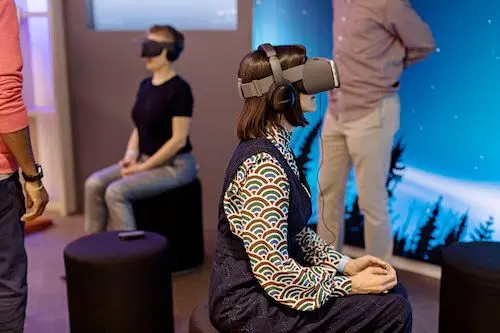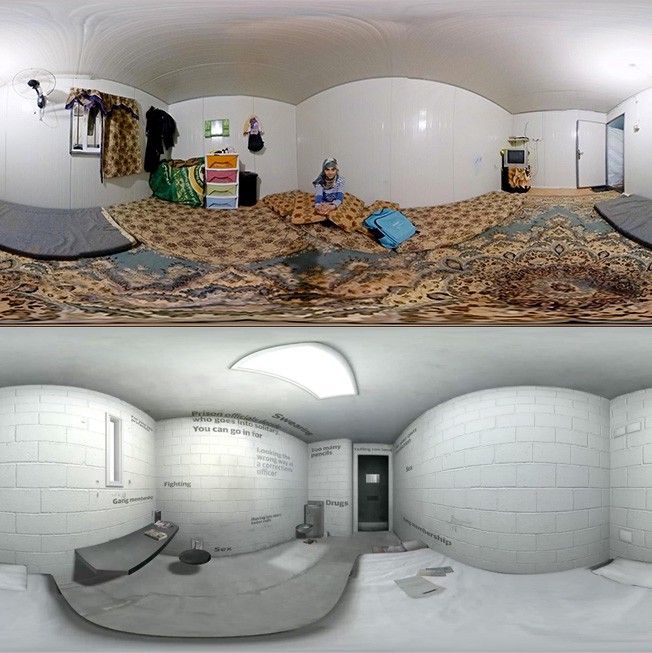May 2024
Alex Garland’s Civil War May Normalize Political Violence


2016-06-17
Virtual reality is in the eye of the beholder. Filmmaker and entrepreneur Chris Milk optimistically calls VR an "empathy machine," while the Wall Street Journal warns that VR's "hype is about to come crashing down." Across this spectrum of opinion, the only thing everyone can agree on is that it's a newly accessible medium offering novel experiences for audiences.
Do these experiences lead to empathy? If you define empathy as, "knowing and feeling what another person knows and feels," of course some VR stories do. So do some books, radio programs, and movies - each in their own way. Saying VR is an empathy machine is like saying a paintbrush is an art machine. There are myriad ways to generate aspects of empathy with media, just like there are infinite ways to create forms of art with tools.
Saying VR is an empathy machine is like saying a paintbrush is an art machine.
The term "affordance" refers to how an object or environment offers the opportunity for us to perform an action. A door handle affords pulling, a knob affords being twisted, and a button affords being pushed.
Every medium has its affordances. Books use the unit of words, which are symbolic and lacking in sensory information. Words afford a writer the ability to express abstract ideas, describe the nebulous internal thoughts of a character, and leverage the subjective imagination of a reader. Radio is pure sound, so it fosters intimacy through sensorial minimalism, and affords multi-tasking in today's busy world. Video is audiovisual rectangular content, which has afforded directors like Stanley Kubrick control of our attention within a scene without each viewer looking wherever they want. Another acclaimed director, Alfred Hitchcock, often referred to his style of video as "pure cinema" - using camera movement, editing, music and sound to tell stories that would be impossible in any other medium.

How would the infamous shower scene from Psycho be directed in VR? What is "pure VR"? What are VR stories that would be impossible in any other medium? The unique storytelling units of VR are space and 1st person perspective.

Two of the most discussed experiences in VR use these spatial and 1st person affordances to pave new avenues for empathy. The Syrian refugee crisis has been described in articles, radio shows, TV news broadcasts, films, and more, but in Clouds Over Sidra you are transported in VR to experience the space - from the huge scale of the camp to the tiny room of Sidra and her family. You look down at Sidra's young brother crawling around the floor, and you look over at her family huddled over dinner in the corner of the room. You learn and feel what Sidra knows and feels by empathizing through space and perspective.
In 6x9: An Immersive Experience of Solitary Confinement, we experience something similarly novel. Words, photos, and videos about solitary confinement afford avenues of empathy, but 6x9 virtually places you in a narrow cell, looking around for things to do, and witnessing hallucinations in 1st person. You learn how isolated and desperate inmates are in such a limited space, and you feel their claustrophobic mental strife by seeing through their delirious perspective.
You learn and feel what Sidra knows and feels by empathizing through space and perspective.

Whether text, audio, video, or VR, there will be little empathy for characters without an emotional rise in audiences. In a media landscape of breathtaking lines of poetry, unforgettable chorus lines we sing along to, and Pixar movies that leave us sobbing uncontrollably over a talking fish's challenges, how is VR uniquely pulling on our heartstrings?
One simple and obvious answer is that VR is new, and new experiences can be emotionally exciting. There is a dismissive framing of novelty as a gimmick, but with infinite potential stories to be told, there are infinite ways we can newly experience scenarios through the affordances of space and 1st person perspective. These novel experiences can add to our emotional understanding of situations and empathy for people involved.
Another channel of emotional arousal specific to VR is its hold on our attention. The more of our sensory bandwidth a medium uses, the more it will consume our attention automatically. VR surrounds us in audiovisual information, which results in a faster ramp up to immersion in an experience that is harder to be distracted from. And until VR starts integrating pop-up advertising & multi-tasking (which is coming fast!), audiences are focusing on a single-task for several minutes. In today's attention economy, this is extremely rare and valuable.
We're frequently inundated by the cacophony of social media, notifications, and a "fear of missing out." Along comes a medium where we are immediately in another world, stuck in there, and focused on one thing. Critics say VR is isolating, but the rapid, persistent immersion in a singular experience is cathartic and emotionally powerful for a society battling constant distraction.
Empathic stories across all mediums are important and powerful. They help us learn and feel for other people, but the impact may sometimes be contrary to our long-term societal goals.
Many stories revolving around social issues guide our empathy to a specific destination. The story directs us to empathize with a different gender, race, nationality, or some "other" group of people. There are good people in pain and bad people causing the pain. The good people are the empathic destination, the bad people are inhuman.
But some stories makes us more empathic people in general, growing our capacity to empathize overall. They contain emotionally complex characters with ambiguous morals, training readers to imagine and infer what a character thinks and feels. These stories exercise readers' empathy like a muscle, building empathic capacity for anyone in any situation. This critical difference between empathic destination and empathic capacity was demonstrated in a study by Emanuele Castano showing how reading literary fiction builds more empathy than reading popular fiction. Empathic destination is direct and specific to a particular situation, while empathic capacity is broadly applicable and cultivates a more unified and empathic society.
Empathic capacity makes us more empathic to those involved in the next crisis, to the annoying colleague, to the homeless people we pass daily on the street, and most importantly to the people most different from ourselves.
Empathic destination is direct and specific to a particular situation, while empathic capacity is broadly applicable and cultivates a more unified and empathic society.
Isn't that the ultimate goal of these empathic stories, VR and otherwise? We want to bring people together, to decrease the rife polarization in our society, and to change hearts and minds to change the world. Stories direct our perspective through abstract words, minimal sounds, and virtual space to remind us that we can think, feel, and act beyond ourselves for everyone's benefit.



